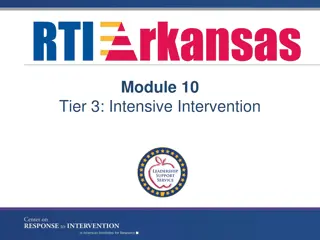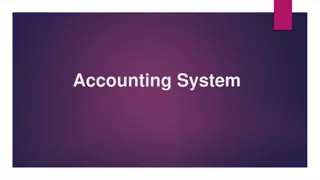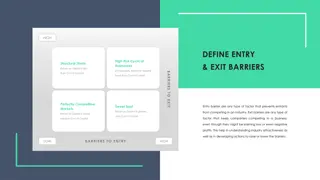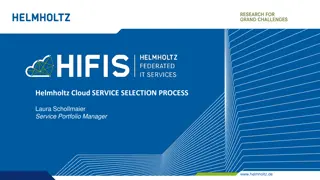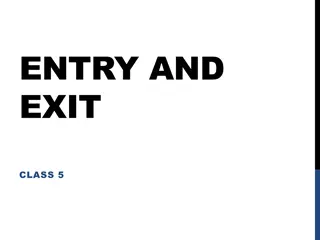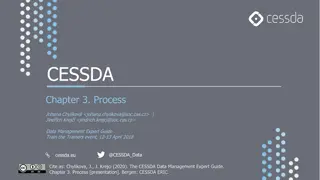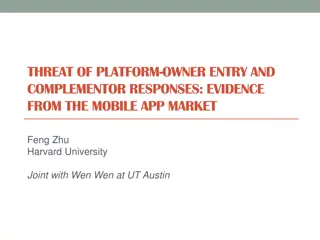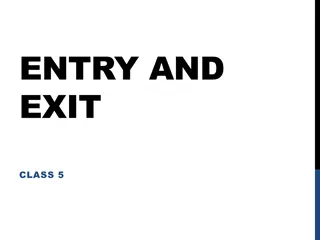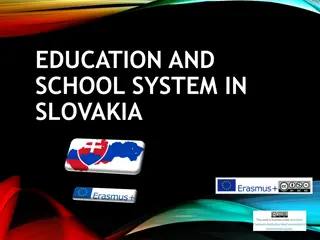Developing Entry Criteria for Tier III Interventions in Schools
This module focuses on helping schools establish entry criteria for Tier III interventions to identify students in need of individualized support. Participants will learn about the importance of relying on multiple sources such as existing school data, staff and family nominations, and universal screening to prevent students from being overlooked. A case study featuring Aiden, a 7-year-old 2nd grader exhibiting challenging behaviors, will be used to illustrate the process of identifying students for Tier III interventions.
- Tier III interventions
- Entry criteria
- Student identification
- School support
- Individualized interventions
Download Presentation

Please find below an Image/Link to download the presentation.
The content on the website is provided AS IS for your information and personal use only. It may not be sold, licensed, or shared on other websites without obtaining consent from the author. Download presentation by click this link. If you encounter any issues during the download, it is possible that the publisher has removed the file from their server.
E N D
Presentation Transcript
Identifying Students for Individualized Support Images in this module were obtained at google.com/images unless otherwise specified.
Purpose of This Module To help schools develop a system for identifying students for Tier III interventions
Participants will learn about Entry criteria for Tier III Referrals from staff and family members Universal screening Objectives
The Tiered Fidelity Inventory (TFI) Tier III Planning Tool TEAM 3.1 Team Composition 3.2 Team Operating Procedures 3.3 Screening 3.4 Student Support Team SUPPORT PLANS 3.8 Quality of Life Indicators 3.9 Academic, Social, and Physical Indicators 3.10 Hypothesis Statement 3.11 Comprehensive Support 3.12 Natural and Formal Supports 3.13 Access to Tier I and Tier II Support RESOURCES 3.5 Staffing 3.6 Student/Family/Community Involvement 3.7 Professional Development EVALUATION 3.14 Data System 3.15 Data-Based Decision Making 3.16 Level of Use 3.17 Annual Evaluation
In each Tier III module, we are going to follow a Case Study to illustrate the process of Tier III. In this module, the Case Study will focus on how a particular student was identified for Tier III interventions. Introduction to the Case Study
Introducing Aiden 7-year-old 2nd grader at University Heights Behaviors: throwing classroom materials, cussing at teacher, and shouting at peers Referred for Tier II interventions Received Big Buddy social skills mentoring three days/week for six weeks, with negative results Is now being referred for Tier III interventions
Establishing Entry Criteria for Tier III In order to keep students from being overlooked, entry criteria for Tier III interventions need to rely on multiple sources. Those sources may include the following: Existing School Data Nominations from staff and family members Universal Screening Lane, Oakes, Ennis, & Hirsch (2014)
Identifying Students Using School Data Non-response to Tier II intervention Chronic behavior Intense behavior
Consider: Was the best intervention match identified? Would the student benefit from more than one intervention? Does the student have a behavioral profile that warrants more intensive intervention? Myth: All students who don't succeed at Tier II MUST move to Tier III
What Was the Response to Tier II? Review Tier II intervention data after at least four weeks and eight data points. Use the same data sources for review. Possible responses: Positive response Questionable response Poor response to intervention Sprague, Cook, Wright, and Sadler (2008, p. 77). Lembke (2010).
Review of Tier II Data What is the student s level of performance? What is/was the desired level of performance? Graph the above, showing a trend line (rate of progress).
Monitoring Student Progress Goal Line Phase Change Line
Was Tier II Intervention Implemented with Fidelity? Was intervention implemented with fidelity? Yes Unsure or No Problem solve possible barriers to staff implementation Student Response Positive Student Response Questionable Student Response Poor
Example: Intervention Implementation Fidelity Checklist
Questionable Response: Problem Solving If the data indicate questionable response to intervention: Check for fidelity of implementation of intervention Reconsider the function Reconsider the goal Modify/adapt the intervention
Concept of Adaptations A continuum with movement between tiers A continuum within each tier
Adaptations to Tier II Interventions Adaptations are modifications or changes to the standard protocol Increase or decrease the dosage of intervention components Add supplemental supports or interventions Modify the format of a core component Timing of adaptations At onset Due to non-responsiveness
Modifying an Intervention How can an intervention be modified or intensified? Provide more frequent feedback Individualize feedback Add a self-monitoring component Individualize the reinforcer
Poor Response: Problem Solving If the data indicate a poor response to Tier II intervention: Review daily progress reports and fidelity of implementation checklists. Review Tier II interventions and assure that they are aligned with behavior concerns and goals. If fidelity, goals, and primary problem behavior focus are assured Discuss changing or intensifying the Tier II intervention. Consider the student for Tier III intervention.
When reviewing existing school data, Tier III teams should use established data decision rules to identify students who meet the entry criteria for Tier III interventions. Data Decision Rules
What are Data Decision Rules? Rules that help you determine if students are eligible for receiving Tier III interventions Rules that help you determine next steps for students in Tier III interventions (e.g., maintaining the intervention, graduating, modifying, etc.)
Developing Data Decision Rules: Where Do You Begin? Decide what concerns about students should be considered. DISCUSSION QUESTION: What concerns might lead a teacher to refer a student for an intervention? Decide what data thresholds signify no current risk, at-risk, or high- risk concern. DISCUSSION QUESTION: At what point would the concern be enough to justify individual interventions?
Some Things to Consider Concerns about students: Discipline referrals Academics Attendance/tardiness Time out of classroom Withdrawal from social situations What is acceptable or proficient for these? What is considered at-risk? What is considered high-risk?
Chronic Behaviors Behaviors that are persistent over a period of time (and possibly in multiple locations). Students with chronic behaviors that do not respond to Tiers I and II may need to be referred for Tier III interventions. Schools need data decision rules to determine when chronic behaviors fall into the high-risk category.
Intense Behaviors Intense behaviors are those that significantly impact the learning of the entire class or those that create concerns for the safety of the student or others. Students with intense behaviors may need to be referred for Tier III supports even if they have not received Tier II supports. Because intensity can be subjective, schools will have to decide which behaviors are always intensive and consider others on a case by case basis.
Behavioral Intensity Is Subjective Examples of possible intense behaviors: Throwing objects Yelling at school personnel, You re not the boss of me! . Leaving the school campus Examples of intense behaviors: Display of weapons Assault on others Self-injury
Some Other Considerations Students that were in interventions in the previous year or at a previous school Students re-entering school from an alternative setting (e.g., alternative high school, mental health facility, etc.)
EXAMPLE: DATA DECISION RULES FOR STUDENT SUPPORT Measure No or Low-Risk 0-4 At-risk 5-9 High-risk 10 or more Classroom minors Office Discipline Referrals Absences Tardiness In-School Suspension Out-of-School Suspension Course Grades Reading Assessment Visit to Nurse (non- medication) Out of Class - Other 0-1 2-5 6 or more >5/semester >10/semester >3 2 Multiple Ds or Fs Below Basic >1/week 0-2/semester 0-3/semester 0-1 0 C or above in all Proficient >1/month 3-5/semester 4-9/semester 2-3 1 D or F in any Basic 1/week >1/month 1/week >1/week
Based on Aidens behaviors and his response to Tier II, do you think he meets the criteria for Tier III interventions? Why or why not? Table Talk
Referrals from Staff and Family Members
Purpose of Referrals Encouraging Tier III referrals from staff and family members makes it less likely that students with internalizing behaviors will slip through the cracks.
Considerations: Guiding Questions Who can refer a student for Tier III interventions? What will be the procedures for referring a student? What professional development is needed to ensure all staff understand the purpose of Tier III and the procedures for referring students?
Determine Who Can Refer a Student Consider this as a team, and then get input from teachers. Examples: Tier II team based on Tier II data reviews Classroom teachers based on classroom concerns, office referrals, internalizing behaviors, etc. Parents based on concerns at school, home, other locations (educational or behavior concerns)
Develop Procedures for Referring a Student Establish procedures for referring a student to Tier III: What type of form or process will you use? Paper or digital? Where will teachers access the forms? To whom will teachers give the form? How will others, such as parents, access Tier III resources or forms?
Collect Supporting Data Develop a process for collecting supporting data: In order to determine the appropriate intervention, how will you collect the data you need? For example: Type of behavior Where behavior is happening How behavior is maintained (consequence) What happens right before the behavior What strategies have been tried Other info that might be useful for the problem-solving team (e.g., grades, out of classroom time, etc.)
Example of Process for Teacher Referral Teacher fills out Request for Assistance form. Teacher collects information that includes the following: The behavior (observable, measurable) The context (where, when, possible motivation, etc.) The strategies that have been tried The screener data that have been collected The teacher then submits the form and the above supporting information as part of a formal request for assistance to the PBIS team.
Example: Teacher Nomination for Assistance TEACHERS ARE EXPECTED TO COLLECT DATA TO ACCOMPANY THE FORM http://cce.astate.edu/pbis/wp-content/uploads/2019/01/Tier-II-Teacher-Nomination-for-Assistance-adapted-from-MO.docx
Purpose of Universal Screening Screening may help detect emotional disorders. Screening may help students at risk get early intervention. Early intervention often leads to better outcomes for students. Rose and Owens, Illinois PBIS Network
Advantages of Universal Screening Quick, efficient, respectful process that includes all children and youth More accurate identification of students in need Informs school of student s needs Evidence-based practice supported by highly noted groups with educational policy and practice
Universal Screening Instruments Screener Pros Cons Well-validated (Endorsed in 1990 by the Program Effectiveness Panel of the U.S. Department of Education) Efficient (Screening process can be completed within 45 minutes to 1 hour) Most effective instrument for identifying internalizers (Lane et al., 2009) Meets AERA/APA instrument selection criteria Inexpensive (Manual= $ 134.49; includes reproducible screening forms) Normed for grades 1-6 Dated norms (normed in 1990) Normative sample skewed to western U.S. region Systematic Screening for Behavior Disorders (SSBD; Walker & Severson, 1990) Can be expensive for districts/schools that don t have access to a scantron machine $26.25 for 25 hand-scored protocols Online access via AIMSweb: Additional $1.00 per student for subscribers and $4.00 per student for non-subscribers) Hand-scoring is time-consuming and reduces access to validity measures Computer software is expensive ($620) Measures behaviors associated with internalizing and externalizing problem behaviors and academic competence Meets AERA/APA instrument selection criteria Incorporates three validity measures to rule out response bias Utilizes large (N= 12,350 children & youth), nationally- representative sample Web-based screening capacity available via AIMSewb BASC-2/BESS (Kamphaus & Reynolds, 2007) Illinois PBIS Network
Universal Screening Instruments, Contd Screener Pros Cons Measures internalizing/externalizing behaviors Free Option of completing pencil and paper, or online version Can be scored online Technically sound: Large, representative normative group Perceived length of administration time Items skewed toward externalizing behaviors Strengths and Difficulties Questionnaire (SDQ; Goodman, 2001) Measures internalizing/externalizing behaviors Free Quick to administer (less than 5 minutes per student; 15 minutes for entire class, depending upon number of students) Easy to understand and interpret score results Technically-adequate Not as accurate as the SSBD regarding identification of internalizers Student Risk Screening Scale (SRSS; Drummond, 1993) Measures problem behaviors, social and academic competence Computer and web-based (AIMSweb) administration and scoring available Expensive: Technical manual=$105.60; Rating forms= $43.75 for package of 25 hand-scored forms; scoring software= $270.00; Scanning software= $640 Can be time-consuming. It takes 10-25 minutes per student to complete the screening instrument Social Skills Improvement System (SSIS; Gresham & Elliott, 2008) Illinois PBIS Network
Developing Procedures for Universal Screening Before implementing universal screening, districts need to consider the following: Which screener will be used? Who will do the screening? What training is required? When will students be screened? How will the results be used? How will parental consent be obtained? With whom will results be shared?
Parental Consent Review state and district policies for conditions under which parental consent is necessary. If you are collecting new data for an individual student for the purpose of determining disability, an assessment plan and parental consent are necessary. If you are reviewing existing data for an individual student or administering an assessment to all students, then no assessment plan and no parental consent are necessary.
Aiden is Nominated Before Mr. Jones, Aiden s teacher, fills out a Request for Assistance form to nominate Aiden for Tier III interventions, he tries these strategies: Reteaching the expected behavior Increasing positive, specific praise when Aiden was following expectations Contacting Aiden s mother Despite these strategies, Aiden s behavior continues to intensify. Mr. Jones fills out the Request for Assistance and submits it, along with the required data.
The Core Team Evaluates the Behaviors The Core Team receives the Request for Assistance form from Mr. Jones. The Core Team determines that the target (problem) behaviors described by Mr. Jones on the Request for Assistance form are both chronic and intense. Chronic they persist over a period of time Intense they negatively impact the learning of Aiden and his classmates
The Core Team Uses Data Using existing school data, the team evaluates whether Aiden meets the entry criteria for Tier III interventions, using the data-decision rules previously agreed upon. Aiden meets these criteria: 10 or more minor behaviors 6 or more office discipline referrals More than 3 in-school suspensions 2 visits to the school nurse each week These data suggest that Aiden may benefit from Tier III interventions.
The Core Team Considers Aidens Response to Tier II Interventions Mr. Robinson, the Tier II Coach and crossover member of the Tier III team, shares Aiden s Tier II data with the Core Team so that they can evaluate his response to Tier II interventions. The graph of Aiden s Tier II progress monitoring data shows a negative response to the Big Buddy Social Skills program. Fidelity data collected from the Tier II team indicate that the Big Buddy Social Skills group of which Aiden is a part is being implemented with fidelity. Aiden s nonresponse to Tier II indicates he may need individualized Tier III interventions.







